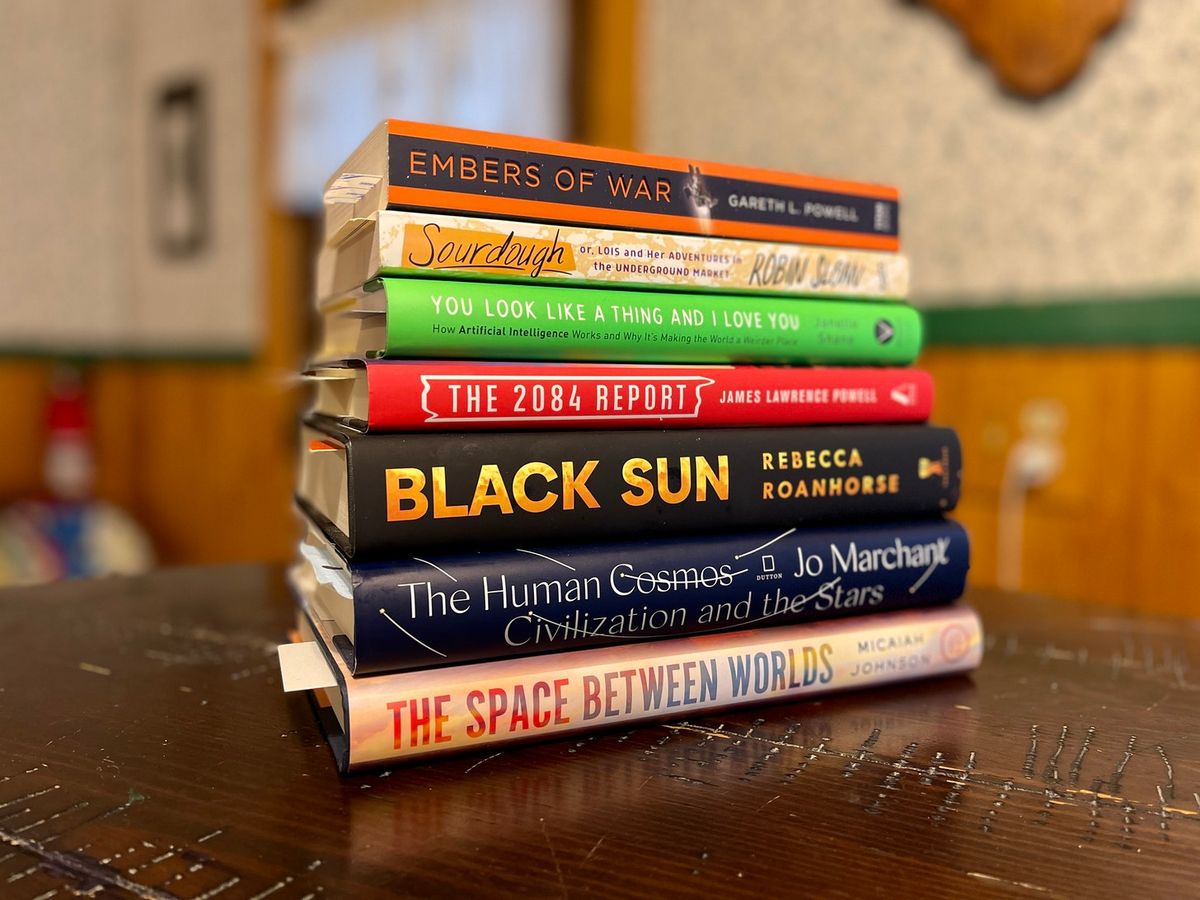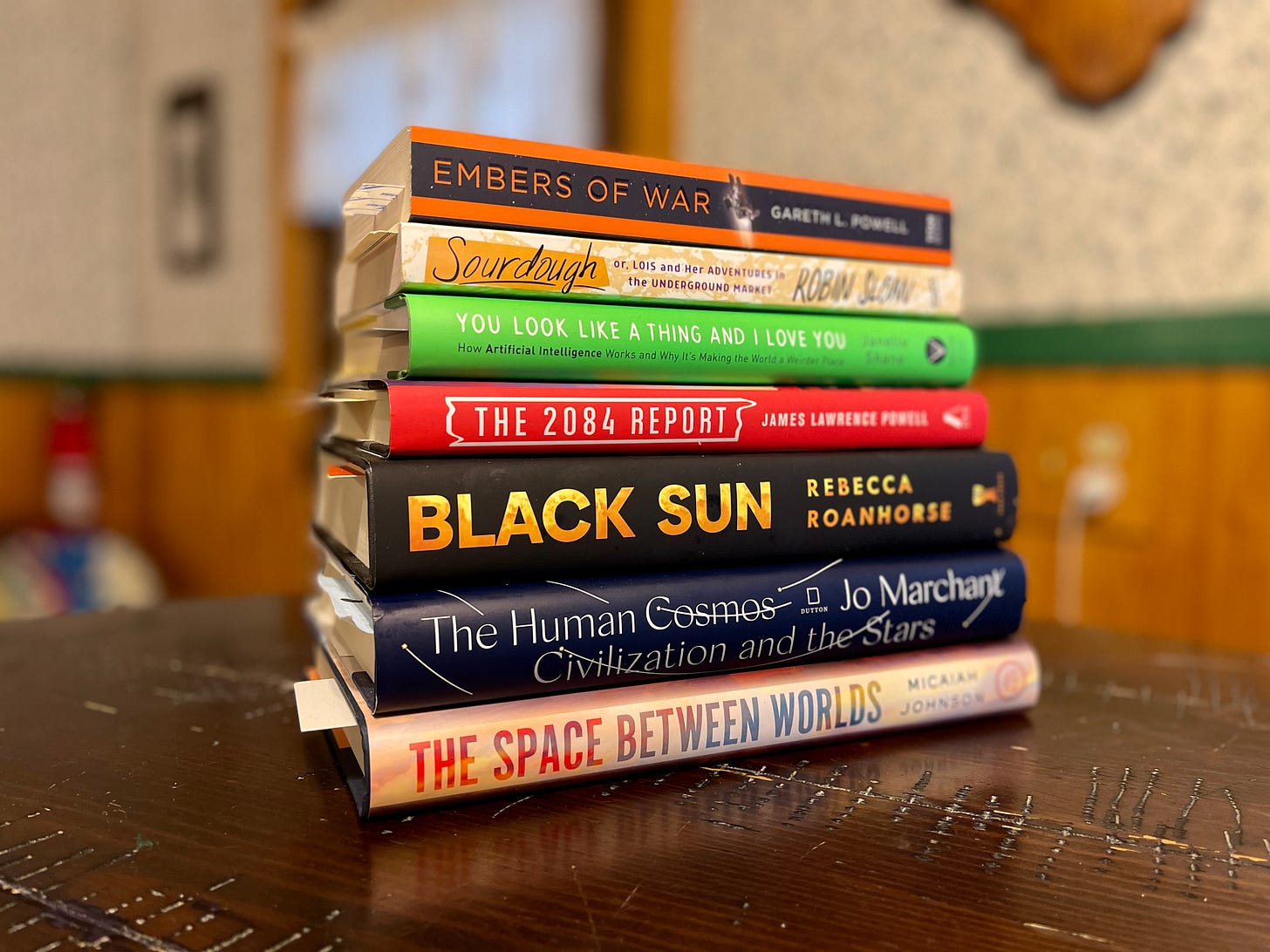Long reads: private space and AI warfare

Greetings!
It’s been… quite the week, hasn’t it? I was incredibly relieved when various networks began to call the Presidential race on Saturday: a weight of uncertainty has been lifted.
Obviously, there’s a lot that needs to happen between now and then: states need to certify their results and go through the process of recounts in a Georgia and Wisconsin, but I don’t see anything drastic happening that will overturn the results. Trump will be out come January.
I am relieved to see the Biden team getting to work, despite the lack of a concession from Trump. After four years, it’s honestly a little amazing to see a competent team of people at work: they’ve already begun releasing plans to combat things like COVID-19, the economy, and more. Just seeing a plan, rather than an incompetent, half-assed set of handwaving and wishes, is wonderful to see. And it’s in complete sentences.
Is Biden/Harris the end to all of the problems that we’re facing? No. But having an actual plan of action, rather than constant, petulant reaction is a start. Biden and his team will almost certainly make mistakes and cause their own problems and scandals, but after four years, I expect that anything they do will be pretty tame in comparison. That said, I do expect the Republican party to act out dramatically every time something goes wrong, ignoring the last four years of legitimate scandals that they’re ignored.
Okay, that’s off my chest. tl;dr, I’m relieved.
Beyond that, it’s been a stressful week. COVID cases are still rising uncontrollably, and even here in Vermont, where the state’s somewhat proactive work has meant we haven’t been hit as hard, we’ve seen huge rises in numbers. I think people are getting tired of the pandemic (which is precisely why we need better planning), and have been letting their guard down. Bram’s school has shut down in favor of remote learning, which is a bit of a distraction, but an honestly welcome one. A silver lining: we got to watch the latest episode of The Mandalorian together today.
This week: I want to point to a couple of longer posts that I’ve published in the last week.
The pitfalls of science fiction

Over the last decade or so, you’ve probably seen news about Elon Musk’s work developing a space transportation company, and some of his more outlandish plans: colonizing Mars and beyond, with the intent of turning humanity into a multi-planetary species.
It’s a laudable ambition, and Musk has garnered a considerable fanbase from space enthusiasts around the world. Science fiction fans nod to each other at conventions, understanding that Musk is also one of them — a fan who’s taken the dream of space travel and turned it into a reality.
I’ve been really interested in how both Musk and Amazon founder Jeff Bezos — as well as other tech founders — have found some level of inspiration from science fiction, but over the years, I’ve come to think that it can be a bit of a misleading influence, especially as authors update their understandings of the cosmos and our place in it.
I’ve written up my thoughts about this for the tech site Pando. The side that I generally come down on is that the futures that they see in SF that they want aren’t great or practical.
Science fiction provides a seductive vision of the future. But SF isn’t a predictive genre: it’s something that’s firmly rooted in the present, in that authors are (generally) extrapolating what they’re seeing at the moment a bit into the future. It’s easy to see a future and think: “that’s a world I’d like to live in”, either explicitly, or in a broader sense.
Some of that is structural: ask any Black reader or writer, and they’ll likely point out that the works of Clarke and Asimov are largely devoid of any people of color — a horrifying concept if you come from a race that’s faced systemic racism and attempts at extermination. Are these futures from Clarke / Asimov designed with explicitly racist intentions? Probably not — they’re simply products of each of their surroundings. (I am really interested to see how Apple’s adaptation of Foundation tackles this — it seems like they’ve made it a bit more inclusive.) I didn’t really talk about this in the essay itself, but I think it’s worth mentioning: the history of SF itself is an unequal one, and that certainly puts a certain spin on those futures you’re imagining, especially when it comes to racial equity / accessibility / etc.
On the other side of things: space is big, and with everything we know about the actual hard realities of space, an interstellar empire isn’t really going to work. Hyperspace, FTL drives, and other shortcuts are simply storytelling mechanisms that push the story forward. Science fiction might have its grounding in realism, but that doesn’t mean that it’s always going to be realistic.
On top of that: while Musk has spoken quite a bit about how we have to adapt to a changing climate and the importance of solar energy, I don’t believe that the answer is investing in solutions away from Earth. As Kim Stanley Robinson noted in my query to him for the piece, any solution needs to involve humanity coming into a much better balance with the Earth, if there’s to be any hope of a successful spread through the solar system. We’re fragile creatures, and the place we’re most suited for is here on Earth. Remove that from the equation, and no matter how interplanetary we end up being, it’ll be for naught.
The [AI]nformation battlespace

Earlier this week was Veteran’s Day, and I decided to use the opportunity to finish up and publish a longish piece that I’ve been working on for more than a year: how the US Army is beginning to think about combatting an enemy armed with an artificial intelligence.
It’s a largely theoretical problem, and I’m not talking about killer robots, but bodies that are using AI to optimize their operations, and thus be more difficult to fight against. It’s an intriguing field, and there are a bunch of people who are just starting to think about it.
This post was released to paying subscribers, but here’s an excerpt:
Under the cover of darkness, a team of soldiers from the United States Special Operations Command quietly makes their way into an unnamed East African city. They’re clad in specialized clothing and makeup that hampers facial recognition software from matching their faces against freely-available online databases of hacked Department of Defense files, and carry secured cell phones to communicate with their home base — a converted cargo ship anchored off-shore in international waters. A team on the ship flies a drone overhead to keep an eye on their surroundings, and relays a live video back to mission control stateside, which keeps an eye on the team’s surroundings and will alert them to any potential threats.
The team’s mission is to track down an individual who stole a piece of technology from a defense contractor. Various US intelligence services intercepted the thief’s communications to foreign intelligence officials, and learned that they’re planning to turn over the tech to them in this particular city. It’s a safe place for a handoff: a decade earlier, the Chinese government had wired it up with an advanced surveillance network, allowing them to autonomously keep eyes on the city’s residents, foreign intelligence and military officials, and everyone else who' might be passing through.
The soldiers in the team have to not only find their target, but do so without tipping off local officials and their Chinese allies, as to avoid kicking off an international incident. Once they have their quarry in hand, they have to make it back out of the city to their ship and into safe territory.
It’s a scenario that sounds a bit like the plot of thriller from Tom Clancy (or from authors like August Cole / P.W. Singer or Linda Nagata) but it’s actually an idea that came out of a group session during a conference on artificial intelligence that took place at the United States Army War College’s Center for Strategic Leadership in Carlisle, Pennsylvania, which has a particular focus on strategic wargaming.
As I’d written about military affairs (real world and science fictional), I was one of the people invited to take part. When I arrived at the conference last year, I found a diverse group of people: military reporters like Breaking Defense’s Sydney J. Freedberg Jr., The Red and The Last Good Man author Linda Nagata, and Empires of EVE: A History of the Great Wars of EVE Online author Andrew Groen, as well as a number of officers from the Army and Marines, ranging from active-duty captains to retired officers.
Our task for the session was to figure out how to set up the parameters for a war game that would simulate a conflict between two adversaries, one armed with an artificial intelligence in charge of their command and control systems, something that military strategists have begun to think about more seriously as technology on the battlefield has undergone drastic changes in the last decade.
Going into the conference were a number of questions: how would a military put artificial intelligence to use, and if it were fielded, how would the country combat an adversary that utilized such a system? And would this particular gathering be a useful stepping stone towards that eventual goal, or would it just be an intriguing thought-experiment?
“We’re not talking about killer robots,” Dr. Andrew Hill, the Chair of Strategic Leadership for the school, told the assembled group in his opening statements. There’s a general wariness in defense circles of James Cameron’s 1984 film Terminator, which set the public image of murderous military robots.
Many within the military community believe that artificial intelligence is the revolution in the history of warfare, seeing it as an inevitable development that’ll permeate every part of the battlefield. If AI can give a military an edge over their adversaries, it’s something that soldiers and planners in the future will need to take into consideration. One way to do that is to use a time-tested training method: wargaming.
This is a post that’s emblematic of the work that you’ll get as a full subscriber. If you liked this post and want to help support this sort of work, please consider subscribing!
(I’m also super pleased with the art in this one, which came from a neat app that I recently found called ArtLeap.)
Currently Reading

Not much has changed since the last roundup. I’ve still got many of the same books that I’m working through, although I missed one last time: The Salvage Crew by Yudhanjaya Wijeratne, which didn’t come out as a physical book, so I’m listening to both the audio and reading it on my Kindle.
I’ve also picked up Sourdough by Robin Sloan, for a project that I’m working on about artificial intelligence and writing, and The 2084 Report by James Lawrence Powell, a “FicInt”-style book about climate change, for another project. Hopefully, I’ll have more details about those soon.
Further Reading
- A good find. A couple of years ago, I caught an indie science fiction film called Prospect, and really fell in love with it. It’s a film that reminded me a lot of Duncan Jones’ Moon in scale and ambition, and it’s now on Netflix.
- Ballpoint. The BBC has a really cool look at something you’ve probably never paid much attention to: the humble ballpoint pen. There’s a cool story behind how it came to be.
- Confessional. My uncle, Kevin Danahy, sold his first poem! You can read it here.
- Defense of Enya. Jenn Pelly has a great feature over on Pitchfork about Enya, and how she seems to be enjoying some newfound popularity. I’m particularly happy to read it, because Enya’s been one of those artists that I’ve listened to since I was a kid, and I’ve never really understood the eye rolling that people direct towards her. Watermark is a phenomenal album.
- F&SF Changes Editors. I interviewed Sheree Renée Thomas about her new role as editor for The Magazine of Fantasy and Science Fiction.
- Forbidden Premiere. Allison Braden writes about the time that Forbidden Planet premiered in Charlotte NC for Charlotte Magazine. It’s a neat story that I’d never heard before.
- Halloween Origins. Over on Cosplay Central, I wrote about how dressing up in costume for trick or treating wasn’t originally a Halloween thing: its origins come from Thanksgiving!
- Ministry of the Future. My friend Gerry Canavan has a review of Kim Stanley Robinson’s latest over in the LA Review of Books.
- Outerwear. Danika Ellis at BookRiot has a neat history of the dust jacket.
That’s all for this week. I’ve got a handful of things coming up in the nearish future: a long read about the story behind Harlan Ellison’s Last Dangerous Visions (subscriber-only), as well as a holiday gift guide and some thoughts on The Mandalorian. Hopefully, I’ll have a couple of other reviews coming up. I also just took possession of a new iPhone 12 Pro, and I’m sure I’ll have some thoughts on that at some point.
Stay safe out there, and wear a mask.
Andrew